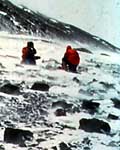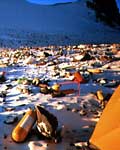
Brent Bishop
| Cleaning Up Everest Brent Bishop of Barrel Mountaineering and NIKE pay to clean up mountains |
 Brent Bishop |
 The South Col in '63 [click to zoom] (photo: Barry Bishop) |
Not only a proficient high-altitude climber, with two 8,000 meter peaks behind him, Bishop has pointed the climbing world in the direction of cleaning up what it has been leaving behind.
In 1994, Bishop not only became half of the United State's only father/son team to have climbed 29,028 foot high Mount Everest (his father, Barry Bishop, climbed it in 1963), he then instituted a precedent-setting campaign to clean it up.
Working to educate mountain guides, climbers, Sherpas, and porters in responsible outdoor practices, the cutting edge adventurer climbed Everest with Scott Fischer, who died tragically on the mountain in '96, and spearheaded the removal of more than 5,000 pounds of garbage left by previous expeditions. By now, he has been instrumental in seeing more than 20,000 pounds (100 tons) of garbage and trash removed from the mountain.
 The South Col in '94 [click to zoom] (photo: Brent Bishop) |
The simple technique used by Bishop and others has been called not only practical, but also both environmentally and ethically sound. Without using expensive technology (early clean-up ideas often involved costly, impractical methods such as high altitude helicopter flights), Bishop came up with the idea of paying a bounty, in cash, on the spot, for oxygen bottles and other trash brought down from the otherwise beautiful mountain. This not only benefited the environment of Mount Everest but also the local population of Sherpas, who received money for their efforts.
Since that 1992 expedition, much of the practices Bishop and Fischer put in place have become more or less standard practice for Himalayan climbing. The mountain environment is only getting better.
In October 1997, Bishop raised the stakes in his efforts when he and climbing partner Kris Erickson ventured into the Karakoram Range of Pakistan, more remote and less traveled than Nepal's Khumbu. With its tall granite spires, jagged peaks of snow and ice, and a plethora of unclimbed peaks beckoning for a first ascent, Karakoram holds incredible opportunity for climbing.
Equally as important, the Baltoro Region of Pakistan gave Brent the opportunity to be proactive in his clean-up efforts. For climbing, and environmental clean-up work, Pakistan is the new frontier. While their objectives for climbing were thwarted by conditions and poor weather, their objectives for environmental education were a complete success.
Now, supported and equipped by Nike, Bishop revolutionizes climbing not so much by new routes but by cleaning up environments that have been trashed by years of less enlightened adventurers.
Brent Bishop has helped to restore the spectacular beauty of the Himalayas, the Karakoram Range, and other mountainous regions.More than just standing on top, Bishop believes part of adventure is responsibility — in not just taking, but giving.
— Peter Potterfield, Mountain Zone Staff
More, more, more...